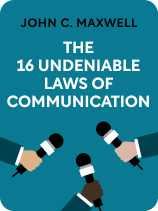

This article is an excerpt from the Shortform book guide to "The 16 Undeniable Laws of Communication" by John C. Maxwell. Shortform has the world's best summaries and analyses of books you should be reading.
Like this article? Sign up for a free trial here.
When you’re preparing to give a speech, what should you do before you start to write? How can you leverage your strengths for maximum impact?
Of course, preparation for public speaking entails writing your speech, but it’s more than that. In The 16 Undeniable Laws of Communication, John C. Maxwell provides tips for drafting your presentation as well as a couple of steps that he recommends you take first.
Keep reading to learn how to prepare for public speaking and create a strong message that’s sure to be remembered.
How to Prepare for Public Speaking
According to Maxwell, even experienced speakers prepare extensively before speaking in front of an audience. When you know how to prepare for public speaking effectively, you’ll be better able to connect with and bring value to your audience. You’ll also develop your communication skills as you reflect on your ideas and plan your approach. Maxwell presents several ways to create a compelling message and prepare for your presentation.
(Shortform note: What does it mean to be well-prepared? Some experts argue that you should know your script “cold”—that is, to know it like the back of your hand. When you deeply familiarize yourself with your presentation, you’ll not only have the opportunity to enhance your communication skills through practice, but you’ll sound more natural and be able to better connect with your audience. To know your script “cold,” craft your presentation at least four to six weeks beforehand and spend some time each day memorizing part of it. Memorize your presentation in random sections so you won’t get derailed if you forget a line.)
Step 1: Team Up With Others
Maxwell suggests you gather a team of people to help you brainstorm ideas for your message and prepare for your presentation. He recommends finding people who are open to new ideas, are flexible when tackling problems, and believe that there are many different ways to solve a problem. Maxwell argues that groups often come up with better ideas than individuals. When you brainstorm by yourself, you can only work from a single perspective. When you collaborate with others, you have access to diverse experiences and insights, which can help you recognize blind spots in your thinking.
When brainstorming, encourage people to come up with as many ideas as they can. Maxwell argues that there are no bad ideas—every thought can be a springboard for greater ideas. You can also have your team ask you challenging questions so you can identify and address potential flaws in your arguments from the beginning.
Step 2: Identify Your Natural Strengths
Before you write your message, it may be helpful to identify your natural speaking strengths so you can build them into your presentation. While learning from other speakers can give you techniques and methods to experiment with, you should write your message in your own voice. If you try to take an approach that doesn’t come naturally to you, like revealing a personal story that you’re not comfortable sharing, you risk losing your connection with your audience.
Maxwell writes that there are four primary strengths you can leverage. Identify which ones come most naturally to you and emphasize them in your presentation:
1. Sincerity: You communicate with authenticity and vulnerability. This might mean sharing stories of your personal struggles and expressing your true emotions. When you open yourself to your audience, they’ll find it easier to trust you.
2. Humor: If you’re naturally funny, try incorporating jokes into your message. Laughter increases feelings of intimacy in your audience and makes them more receptive to your words.
3. Helpfulness: If you’re motivated to help people, focus on offering more practical advice. People appreciate and think more highly of you when you give them the tools to improve their lives.
4. Inspiration: If you tend to see the best in others, you can use your words to inspire them. When you help others envision a better life and show them that it’s achievable, they’ll feel better about themselves and be more willing to hear what you have to say.
Step 3: Write Your Message
Once you’ve prepared for your presentation with your team and identified your strengths, write your ideas into a clear and engaging message that will make a lasting impression. Maxwell describes several steps for turning your research and preparation into a memorable message:
1. Develop your thesis. This should be a single sentence that sums up your message. Maxwell writes that you must clarify your thesis before communicating anything—if you don’t know your thesis, your audience will have an even harder time understanding it.
2. Research and plan out your talking points. Create a basic outline of your main points and gather supporting material such as data, stories, and ideas. Maxwell recommends you experiment with ways to organize your main points so that the audience sees how they’re all connected: Consider numbering them, arranging them in an acrostic (a word that has each of its letters spelling out a new word or sentence), or using a common word in each of your major points. Once you have your basic organization, you can then sort the supporting material you’ve gathered under the relevant points.
3. Plan your transitions. Once you have your main points in order, plan out how you can shift smoothly from one point to the next. At the start of your presentation, don’t just jump into your thesis, but find a way to lead into it. Consider using a quote, telling a story, asking a question, or simply taking time to connect with the audience. As you progress through your presentation, Maxwell suggests using various cues to indicate when you’re transitioning to a new point. Make a note to pause, walk to a different spot in the room, change your facial expressions, or vary the volume, speed, or tone with which you speak.
Engage Your Audience With Visuals and Stories
When creating your message, Maxwell suggests you use visual imagery and storytelling to keep your audience engaged as you speak. These strategies make it easier for your audience to grasp your arguments and remember them.
First, incorporate visuals into your presentation. You can use body language, metaphors, or actual visual aids like physical props and imagery to help illustrate your ideas. Maxwell explains that people remember images better than words and that most people are visual learners.
Second, Maxwell suggests you tell the audience a story to make your points more accessible and engaging. He explains that people remember stories because we naturally use stories to make sense of our lives. You can tell stories from your personal life or share the stories of others, but make sure that they’re relevant to your audience and the points you’re trying to make.
Simplify Your Message
When writing your message, Maxwell recommends you simplify your ideas to be clear, concise, and memorable so that your audience can better understand and remember them.
First, to simplify your message, use language that an eighth grader can understand, and trim excess information that might distract from your main points. Many speakers are afraid of being simplistic, but Maxwell argues that “simple” doesn’t mean you’re watering down your ideas or glossing over complex topics. Instead, “simple” means making your content practical and easy for your audience to understand rather than trying to sound impressive.
Second, make your message memorable by coming up with unique and catchy phrases. Try putting a spin on well-known sayings, such as changing “Practice makes perfect” to “Practice makes character.”

———End of Preview———
Like what you just read? Read the rest of the world's best book summary and analysis of John C. Maxwell's "The 16 Undeniable Laws of Communication" at Shortform.
Here's what you'll find in our full The 16 Undeniable Laws of Communication summary:
- The secrets to becoming a confident and effective communicator
- How anyone can master public speaking, no matter how nervous they get
- How to write a clear and engaging speech






